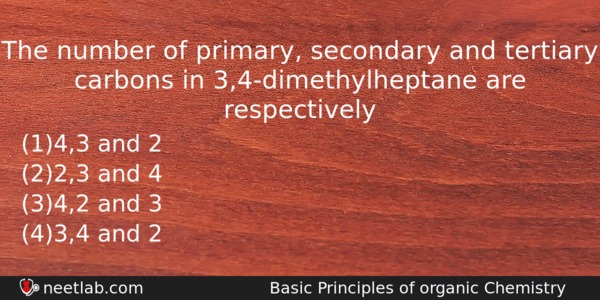| ⇦ | 
| ⇨ |
The number of primary, secondary and tertiary carbons in 3,4-dimethylheptane are respectively
Options
(a) 4,3 and 2
(b) 2,3 and 4
(c) 4,2 and 3
(d) 3,4 and 2
Correct Answer:
4,3 and 2
Explanation:
No explanation available. Be the first to write the explanation for this question by commenting below.
Related Questions: - The s-block element used as a catalyst in the manufacture of Buna-S rubber is
- The catalyst used in Ziegler process for polythylene manufacture
- Hydrogen burns in air with a
- Which of the following hydrides is electron deficient molecule?
- Which of the following is not correct regarding terylene
Topics: Basic Principles of Organic Chemistry
(124)
Subject: Chemistry
(2512)
Important MCQs Based on Medical Entrance Examinations To Improve Your NEET Score
- The s-block element used as a catalyst in the manufacture of Buna-S rubber is
- The catalyst used in Ziegler process for polythylene manufacture
- Hydrogen burns in air with a
- Which of the following hydrides is electron deficient molecule?
- Which of the following is not correct regarding terylene
Topics: Basic Principles of Organic Chemistry (124)
Subject: Chemistry (2512)
Important MCQs Based on Medical Entrance Examinations To Improve Your NEET Score
18000+ students are using NEETLab to improve their score. What about you?
Solve Previous Year MCQs, Mock Tests, Topicwise Practice Tests, Identify Weak Topics, Formula Flash cards and much more is available in NEETLab Android App to improve your NEET score.
Share this page with your friends

Leave a Reply